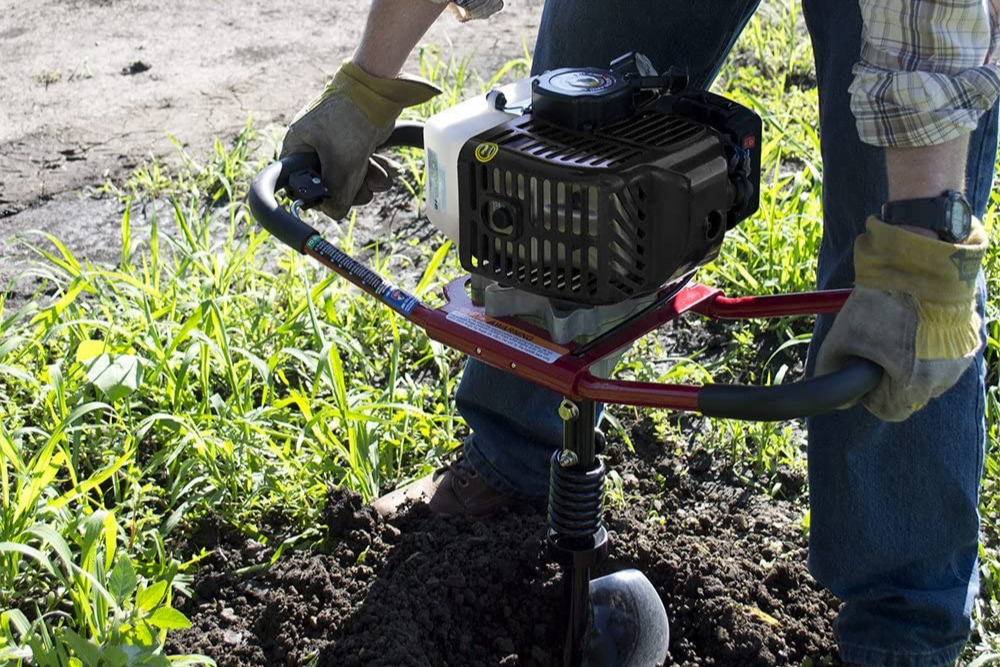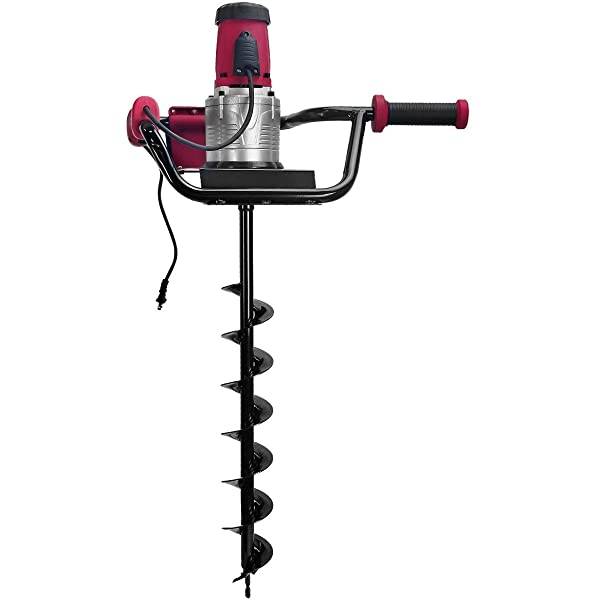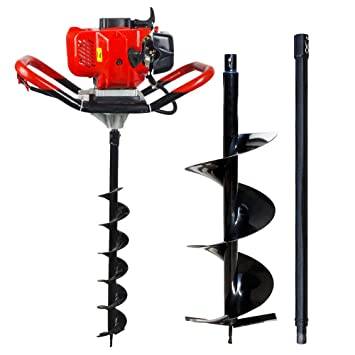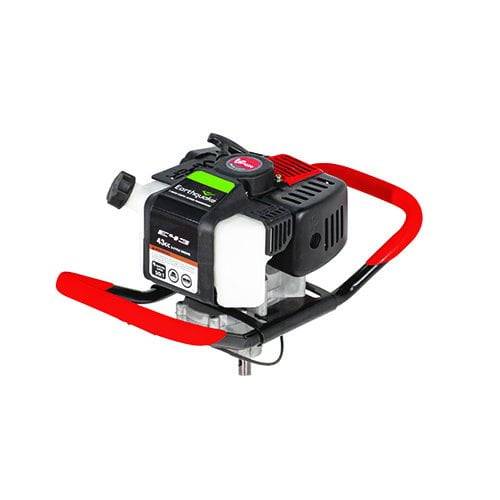Now digging a pit for planting is now simple for you with the support of the Post Hole Digger Machine. This machine can also be referred to as a ground auger. These auger drill tools help produce a first hole or deep gap to cultivate a plant or put in a fence around an agricultural area.
If you have determined that installing a fence around your yard is the next experience, then the first thing you will want is a means to dig holes. There are two instruments you use: a post hole augers and a digger.
The gap between an auger and a digger boils down to the contour. An auger appears like a giant corkscrew, and they make a hole by pushing down the dirt. Posthole diggers seem like just two shovels facing each other, and they make a pit by scooping and taking away the dirt. Post hole Augers are usually motorized, and diggers are generally manual. But, you can find a manual auger that uses a corkscrew design along with a handle. Augers, manual or otherwise, need less effort to utilize and produce more uniform holes. But they are not necessarily as powerful as diggers when stones and other obstacles are encountered.
So, this post contains all the details information of Post Hole Digger. Here you will get your best tool. We will talk about how to use post hole digger? What is the post hole digger price? And best post hole auger for your project.
What is a Post Hole Digger?
Nonetheless, these useful devices may be used for much more than digging. They are amazingly capable of removing dirt out of somewhat hardened dirt for planting or amending and may be employed to make larger-sized holes in addition to single pole holes. They may also be utilized to start trenches for performing irrigation or other similar deep grinding tasks.
It is a wonderful way to move dirt for your current job/requirement.
But why do you require a post-hole digger when you’ve got a shovel? This has a great deal to do with how big the hole you need to dig. A typical shovel mind will dig a much bigger gap than you may need, which usually means that the dirt around your post will be milder from being transferred. While this will not make a great deal of difference when you’ve got loamy, soft dirt to start with, for people who have hard-packed clay lands, it surely does. If your land is quite strong or has plenty of stones, a post hole digger is a vital tool to have.

Types of Post Hole Diggers
There are many tools to assist dig holes, from regular shovels to heavy excavators and numerous kinds of post hole diggers to select from.
Manual
Manual post diggers would be the most typical and conventional solution for digging holes for fence posts, mailboxes, and plenty of different jobs. They seem like giant salad tongs, using a pair of long handles and two hinged scoops at the finish.
Manual post diggers operate by injecting the scoops into the ground, working the grips back and forth a couple of times to loosen dirt and stones, then scooping them from the pit. A few post digger arrive with dimensions on the grips to monitor progress fast.
This choice is the most mobile option and also the simplest to function –in concept. However, the effort necessary to dig deeper and heavier can wear out the consumer’s hands, arms, and back.
Gas
Regarding boring deep holes in a rush, a gas-operated pole digger is your thing to do. These machines also have gasoline-powered motors mounted on top, like those found in weed whackers, chainsaws, and lawnmowers.
The motor turns a huge drill, letting it inject deeply into the floor. On down the road, the auger excavates a few dirt and stones from the pit, but in addition, it calms the remainder to enable draining the gap relatively readily with subsequent moves.
There are occasions in which a gas-powered post hole digger will bury itself in the ground, catching onto a difficult root or stone. In those instances, taking away the digger may be a little more difficult, so it is something to remember.
Electric
Electric models are rather like gasoline versions, only with no gas fumes that are damaging. These are excellent if you’re within the easy assortment of a power supply and have a tendency to operate considerably quieter than their gasoline counterparts. But if you’re installing new fencing about the outer reaches of your multiple-acre house, you might find it even more challenging to find electricity to where you are at.
Electric pole hole diggers have a choice of augers accessible, with changeable blade widths and comparable petrol versions. However, weight-wise they are roughly the same as a gasoline version.
What to View When Purchasing the Best Hole Digger
Before choosing a post hole digger, there are a couple of variables to consider. To start with, ensure the digger has the ability to take care of business. It additionally must be sufficiently light to deal with when working alone. This segment will feature those regions to remember some different elements while picking the best post hole digger for your undertaking.
Engine or Motor
Some surfaces and soils are easier to dig than others. When using a powered post hole digger, make certain it’s capable of tackling the job at hand–a lot of this depends on the motor or engine (also called a powerhead) that forces the auger.
Start looking for a version 40cc or bigger. Electric powerheads normally arrive with advice regarding wattages and amps. Models with 1,200 watts or more work also are sure the engine has a 10-amp engine to stop it from overheating.
For powerhead design, start looking for a model with 11/2 horsepower. If the soil is rough, compacted, or filled with stone, think about a greater horsepower alternative –nearer to two 1/4. It may be difficult to find that kind of electricity from an electric pole digger, so remember that rougher terrain may demand a gas-powered version.
Weight
While electricity, post hole auger dimensions, and thickness are significant, none matter more than weight to securely or easily function the pole digger. The consumer requires a machine to manage and eliminate the hole filled with dirt and stones.
- Manual post hole diggers would be the lightest choice, often weighing about 10 lbs. Despite all the scoops filled with stones and dirt, it is uncommon to lift over 20 pounds in the gap.
- Electric article hole diggers position at the center in regards to weight. They generally weigh in the field of 20 lbs, which makes them the most suitable mix of power and weight for your casual DIYer.
- Gas-powered post hole diggers are undoubtedly the heaviest alternative. They could often weigh over 40 lbs. The excess weight permits them to dig in the dirt readily, but it could also make them difficult to eliminate.
Auger
Another thing to comprehend when picking a powered post hole digger is your auger. The drill is that the spindle that bores to the floor. Augers come in a couple of sizes, so it is vital to decide on the suitable size for your undertaking and machine. Deciding on the suitable auger size is based upon the job.
An 8-inch auger allows for putting a 4×4 pole on the floor with sufficient space for concrete to anchor it. A 12-inch auger, finest attached to a thick machine, will produce a hole big enough to get 6×4 or six ×6 poles and a good deal of concrete. Smaller augers, such as 4- or 6-inch possibilities, are acceptable for light-duty functions like mailboxes in addition to metal fence posts to get chain-link fences.
Remember that the bigger the auger, the further friction it will make while dull to the floor. Just a potent engine could turn a 12-inch auger in densely compacted dirt, in which a 4-inch auger may appear to zip to sandy terrain with light-duty models.
Professional tip: When digging a pit is proving hard, think about beginning with a bigger auger first, then swap in bigger augers as the task progresses. Save yourself time by digging all of the holes together with the bigger auger and then coming back together with the bigger drill.
Depth Capacity
Among the most crucial components to consider when digging a pit is how heavy it will have to be. Tall privacy fences produce a good deal of leverage in windy weather conditions, and they can easily uproot a shallow pole. Additionally, installing a fence post auger over the frost line can get the earth to heave it up and from the hole in chilly weather.
Most guide post hole diggers have handles that allow digging down to depths of about 4 ft, which can be code in several regions, such as deck and fencing posts. A thickness of 4 ft will even bring you under the frost line in all but the most arctic lakes.
Start slow, however. Burying an auger 4 ft deep to the floor will make it rather hard to eliminate, so clear out the hole every 6 inches or so.
Handles
Whether employing a manual choice or a post hole digger with a powerhead, give some idea to the grips. They will be the user’s major points of touch with the instrument for hours and hours so that they have to be comfortable and extend the leverage required to bore or spade and get rid of the tool as readily as you can.
Long-handled guide diggers permit more grip from the hole to get scooping rocks and dirt, making it less prone to eliminate the dirt back in the hole because the instrument comes out. Additionally, they could dig deeper.
Broadly, wider grips are better for powered components. Wider handles allow better control over the winding character of a post hole digger, and a spouse can help if the digger gets firmly trapped in a pit.
How to use a Post Hole Digger?
Post Hole Digger Uses:
Before starting to digest, you want to get well prepared.
Heavy clay soils or rocky lands should have been provided a good soaking within the previous few days to permit the dirt time to liven up a little. You wish to wait at least a couple of hours following the final soaking, so you are not drilling to the sand.
It would help if you had leg and foot protection, despite a manual version. For a guide, this is mainly to protect your legs and feet out of the edge of the steel blades. Eye protection is also a fantastic option in case any stone shards begin to fly.
If you are working on an irregular surface, such as the side of a mountain, you would like another person to help. If you are off-balance, your pit might not be down, and it might be more difficult to control your machine. A guide post hole digger is readily adjusted. A vibrating, thicker machine is more demanding.
For gasoline types, make certain the gas tank is full of fresh fuel, and the carburetor is not gunked up from a lengthy storage period.

Best Post Hole Digger

XtremepowerUS 1200W 1.6HP Electric Post Hole Digger
By XtremepowerUS, this electric post hole digger can manage many common excavating jobs. It weighs under 30 lbs and comes with a grip-mounted lockout change and activate, making it comfortable and user-friendly. The device includes a 1,200-watt, 10.9-amp engine which generates 1.6 horsepower and 90 lbs of torque. Using an expansion cable, plug the instrument into a regular electric socket. From that point, you will have the ability to run this silent tool anyplace the cable will reach.

AMES 2701600 Post Hole Digger
Digging holes isn’t a great deal of fun, but occasionally it is the most suitable or maybe the only alternative. For all these situations, take a look at this post hole digger out of AMES. This conventional manual post hole digger includes a 6.25-inch spread in the stage and weighs under 9 lbs, helping dig holes 4×4 fencing posts with no massive machine.
The AMES post hole digger includes two hardwood handles with cushioned grips for preventing blisters and exhaustion. They also have dimension hashes for specifying the thickness of this hole without taking a tape measure.

ECO LLC 52cc 2.4HP Gas Powered Post Hole Digger
For a job that demands a thick post hole digger, contemplate ECO LLC’s gas-powered version. Its strong two-stroke engine forces the auger into demanding, compacted dirt. This unit also includes two broad handles using a grip-mounted controller for simple control and a 1.2-liter gas tank for prolonged use.
This kit includes a 6- and – 10-inch auger, providing the capacity to handle smaller jobs such as metal poles and mailboxes in addition to heavier-duty 4×6 articles and footings. Additionally, it has an expansion to dig holes to depths around 55 inches.
Meaning, this is a hierarchical tool that needs substantial power to maneuver and function successfully.

XtremepowerUS 1500W Electric Post Hole Digger
This post-hole digger’s high-wattage, the 10.9-amp engine, generates around 90-foot lbs of torque–more than sufficient to wiggle stubborn stones lose–even though the instrument being comparatively lightweight at under 30 lbs. You will find just two thick, nonslip grips for maintaining this potent pole digger in check for the simplicity of operation. The tool also comes with a grip-mounted trigger along with a security lockout switch. Contained is a 6-inch auger that measures 28 inches.

Earthquake E43 1-Person Earth Auger Powerhead
In case you’re seeking the ideal post hole auger from the gasoline class, look no more. The Earthquake has a rather strong 250 RPM two-stroke engine which could easily manage to turn the auger bit through any soil type. Additionally, it has got an extremely large selection of auger bits and thickness extenders available, in addition to replacement hints. The handles are made to be anti-fatigue handles, reducing the vibration levels appreciably. Overall, suppose you would like to easily obvious that area for your tree or the deck article. In that case, this will do it fast, easy, and using a minimum of fuss using this particular option for the finest gasoline pole digger.
The Benefits of Owning a Post Hole Digger
Even though it may not look like a great deal of effort to dig a pole or 2 using a spade, the dimensions of this hole needed may wind up appearing enormous. Having a pole digger signifies the chance to earn virtually any place on the lawn with no large-scale excavation job or jumble.
For the normal individual, digging post holes would be the most gratifying part of a fencing endeavor. They may be backbreaking to dig, and the procedure can appear to go on eternally. Employing a pole digger can cut the amount of time spent grinding holes.
- Post hole diggers have other applications too. Many ice anglers utilize pole diggers fitted using 4- or 6-inch augers to drill in the ice’s surface.
- Prevent large-scale excavations as well as the messes which go together.
- Post hole diggers reduce the amount of time that it takes to finish jobs.
FAQs
If you do not have a great deal of expertise with post hole diggers, you may still have some queries about these, what they could do, or how they work. This area is for you. Listed below are a couple of of the most often asked questions regarding post hole diggers.
How long can I dig with a post hole digger?
Post hole diggers can dig very deep since you can add extension bits to keep digging. But, many extensions may make the system to be tricky to lift or put from the hole. Broadly, auger spans over 5 feet may get hard to control.
What are the benefits of a manual option over a powered one?
The most important benefit of a manual post hole digger within a powered is your price. Guide diggers are inclined to be much more affordable. They are also exceptionally portable and do not take a battery, gas, or an extension cable.
What is the difference between an auger and a post hole digger?
The gap between the two is in how they dig holes. You push a conventional pole digger to the floor and eliminate the dirt between the scoops. An auger to the ground and also transports dirt across the blade around the surface.
